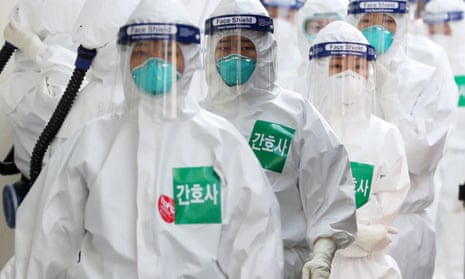South Korea is one of the few countries that has succeeded in flattening the coronavirus curve. Its policy of testing, tracing and treating without lockdowns has been widely lauded. Some attribute this to South Korea’s experience of having dealt with previous epidemics such as Sars and Mers. Commentators in the US tend to stress the country’s effective leadership, contrasting it with that of Donald Trump’s. Others point to cultural factors, such as the willingness of the public to sacrifice privacy for the greater good.
What is often overlooked, though, is that at the roots of South Korea’s success against Covid-19 are a well-funded and efficient system of delivering public services. Without this baseline infrastructure, the policy of test, trace and treat could not have been sustained or expanded to the degree that it has. Likewise, effective leadership cannot achieve much if it lacks a well-oiled public service system that can deliver.
Take South Korea’s biggest international airport, Incheon. As a publicly managed airport, it is consistently ranked among the best in the world. Likewise, the Seoul metro system is world renowned for its cheap fares and efficiency, making it one of the top five underground systems. By far the most impressive aspect is South Korea’s single-payer healthcare system which was ranked the first among OECD countries in 2015. Although hospitals in Korea are mostly privately run, 97% of the Korean population is covered by the compulsory national health insurance scheme. This balance between privatised hospitals and public insurance system has ensured universal accessibility and ample resources, proving its effectiveness in the coronavirus crisis.
How did South Korea achieve this? Unlike in western Europe after the second world war, establishing a welfare system was not the priority of the dictatorships that ruled the country. Like many developing nations in Asia, the emphasis was on industrialisation and economic growth. At the same time, the dictatorship invested heavily in public infrastructure, viewing it as indispensable to Korea’s growing industries. In 1977, the country’s first national health insurance system was introduced, although this was nothing like the comprehensive healthcare of today.
The restoration of democracy in 1987 did not change this state-led economic model and infrastructure management. What changed, however, was the attitude of the people. The toppling of the military dictatorship in 1987 was the result of a series of nationwide protests. Throughout the 1990s and 2000s, South Korea saw numerous mass civil protests against a wide range of issues, from the import of US beef to government mismanagement of a ferry accident in 2014. The apex of this mass mobilisation were the demonstrations against the previous president, Park Geun-hye. The protests continued from October 2016 to March 2017. On 3 December 2016, an estimated 2.3 million people took to the streets, almost 4% of the entire population. These subsequently led to Park’s impeachment and imprisonment.
Korean politics since the 1990s can thus be characterised as a period during which citizens became increasingly emboldened in their relationship with the state, forcing governments to take their wellbeing seriously. One area that this has been the most conspicuous is in public transportation, energy and healthcare. For the average person, these are everyday services that all citizens have the right to enjoy, and which are paid for by taxpayers’ money. To put it in more utilitarian terms, they are the most tangible barometers with which to judge the government’s commitment to its citizens. Failure to improve their qualities and manage them properly almost always leads to a loss of votes for the ruling party in upcoming elections.
This sensitivity to public services and responsiveness to hold government accountable has been the spur behind the improvement of South Korea’s public services for the past 20 years. It also makes privatisation difficult to accept. Not only does it go against the ingrained sense of communal entitlement but also, seeing that services have improved under government, many question the logic of selling them to private companies.
The irony is that for many years, Koreans believed that having world-class public services was equivalent to becoming more democratic and thus more western. Many were unaware of the widespread privatisation and outsourcing of public services that was taking place in the west at the same time. The coronavirus crisis plunging Europe into chaos has shattered this idealised image. As far as Koreans are concerned, this has been a vindication of a supposed “Korean model” which they have fought for over many years. It is unlikely that it will go away anytime soon.
